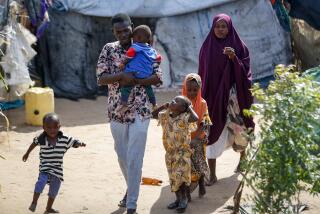CULTURE : Through the Ages, the Camel Helps Somalia Over the Hump : Animals are symbols of toughness in a hardscrabble society.
BUR ACABA, Somalia — Call them haughty, individualistic, clannish, rugged, crafty--maybe even selfish and merciless, Somalis say. But first understand why.
In a word, the reason is camels.
“Livestock is Somalia, and Somalia is livestock,” Mohamoud Abdillahi, chairman of the national Livestock Commission, explained, waxing lyrical about his livelihood and favorite topic. “The camel is our dollar, part of our heritage, our life.”
By practically invading an isolated African country with giant quantities of humanitarian aid and military muscle, the United States and other Western countries have brought themselves face to face with a social system evolved by pastoral nomads over the centuries to endure a supremely hostile environment.
“What is important here is survival--anything that doesn’t have to do with survival has no place in Somalia,” said Abdillahi, a veterinarian by trade. “It’s kill or be killed. Only the toughest trees can live here, and it’s like that with people too. Only the extremely fit survive. The old or sick get left behind.”
Niceness, in American terms, is just not a priority here, as some foreigners have found. Somalis bred after centuries of fighting each other for scarce grazing land and water for themselves and their herds don’t say “excuse me” or “please” to each other. Those words are considered pointless, they explain.
To the outsider, this land soon comes to seem like a giant Western set inhabited by tough-as-nails Clint Eastwood types. Plus, of course, the sand-colored, graceful camels who amble by this inland town and countless other locales as herders guide them to market.
At 1,800 pounds and more, Somalia’s camels are the biggest in Africa, their owners proudly boast. They furnish the tough but tasty meat eaten here with spaghetti, the milk sold by roadside entrepreneurs in scavenged plastic bottles, the hides used to build tents, the dung used to build the walls of huts.
The elegance of the women of northern Somalia is likened to the grace with which a camel picks its way through the shifting sands. A beautiful bride may cost her suitor 100 camels.
“We Americans may like to think of ourselves as individualists, but when we see a stranger riding by, I think our instinct is to invite them in for a drink,” said one U.S. resident of Mogadishu, the capital. “Not the Somalis. In the desert, when two of them met, the feeling was that only one should walk away. It’s a zero-sum game out there.”
So, although Somalia is that rare African country with a single culture, religion (Islam), language and ethnic background, much of the population felt no moral compulsion to help fellow countrymen.
“The camel man for us is the equivalent of two other men--strong, intelligent, resistant,” Abdillahi said.
The camel--in Somali, gel --is not just the raison d’etre for clannishness and division in society, it is also a key economic resource. With less than 1% of Africa’s total human population, Somalia has 43% of the continent’s camels.
Four years ago, there were 6.3 million camels in Somalia--more camels than people.
As Somalia puts itself back together, camels and other types of livestock--cattle, goats and sheep--must again be the foundation of national prosperity.
For Somalis, though, a camel is hardly mere livestock.
“Somalis admire toughness, resilience, hardiness in the environment,” Abdillahi said. “And are these not the very characteristics possessed by the camel, of which it says in the Holy Koran, ‘Look what I have created for you--the camel!’ ”
More to Read
Sign up for Essential California
The most important California stories and recommendations in your inbox every morning.
You may occasionally receive promotional content from the Los Angeles Times.










